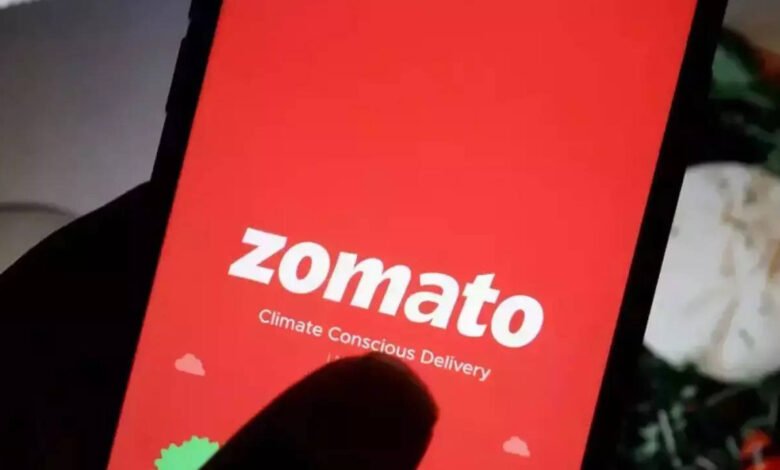Zomato’s Q2 revenue increased by 62% while its net loss shrank to Rs 251 crores.

Zomato’s Q2 revenue increased by 62% while its net loss shrank to Rs 251 crores.
Zomato‘s consolidated income increased by 62.20 percent, or Rs 1,024.20 crore, to Rs 1,661.30 crore, compared to the same quarter last year. Zomato recorded a combined net loss of 250.80 crores on Thursday for the July – September period. This was greater than the Rs 186 crores loss for the June quarter but lower than the Rs 434.90 crores loss for the same period last year.

According to the company’s BSE report, the purchase of Blinkit (quick Commerce) concluded on August 10, and the September quarter results contained 50 days of Blinkit financials. Consolidated revenue increased 62.20 % to Rs 1,661.30 crore for the quarter from Rs 1,024.20 crore in the same period last year.
“I’m pleased with the Blinkit purchase so far. The basic economic model and high customer uptake appear to support our premise. I’m thrilled about where this company is going (nervously). I’m aware that the majority of investors now place zero value on the Blinkit company, and that makes sense. But I have faith that this will improve in good time, “said Deepinder.
Zomato does not currently plan minority investments, and the company claims that capital allocation plans have not changed since the quarter that concluded in June. Akshant Goyal, chief financial officer (CFO) of Zomato Ltd., stated, “We have our plates full with three potentially huge businesses—food delivery, Hyperpure, and fast Commerce).

Intercity Tales (intercity food delivery) and Zomato Immediate (groceries in 10-15 minutes) are two examples of new initiatives within the “food delivery” industry, but Akshant continued, “We have been on the glance for new and possibly large growth concepts for the longer – term growth of the business.”
According to Zomato, Blinkit’s gross order number (GOV) increased by 26% on a quarterly basis to Rs 1,482 crore, and its income increased by 44% every quarter. Quick Commerce’s adjusted Ebitda loss decreased from Rs 326 crore to Rs 259 crore in the June quarter, resulting in a distributable Cash (as a percent of GOV) of negative 17.5 percent in the July – September period as opposed to minus 27.8 percent in the third period.
Average monthly transactional clients for the food delivery industry increased by 4.4% consecutively to 1.75 crores in the third quarter of 2018 from 1.67 crores in the second quarter.
“I believe there is potential for the organizations to expand much quicker than it is now trending at, despite the fact that our meal delivery service has been growing and moving steadily in the direction of profitability. Since we might have innovated & executed more effectively over the past few months, I’m not sure if I can credit this to the macro-environmental factors. India’s food and beverage delivery industries are still in their infancy. Therefore, we must work tirelessly to seize this significant opportunity, “said Zomato CEO Deepinder Goyal.
Goyal stated that if his company has been unable to execute correctly and provide both profitable growths at once, he will become concerned as a stakeholder. Goyal noted that his organization is committed to doing a fantastic job in all facets of creating an excellent corporation.
“Will we commit errors? Yes. But I think making errors is acceptable as long as you learn from them. We are constructing for the long run, and we will keep assessing and placing bets that can jeopardize short-term aspirations for the extended future, “added he. Despite challenges from inflation, the organization hasn’t really noticed much of a reduction in rapid Commerce. Although the majority of investors presently place no value on the Blinkit business, Zomato is optimistic that this will change in due time.
The increase in average order value and order volumes contributed to the gross order value’s 3% QoQ and 23% YoY growth. The increased revenue per order contributed to the food delivery company’s more incredible adjusted revenue growth. In terms of profitability, the contribution margin expressed as a percentage of gross order value increased significantly from 2.8% in Q1 to 4.5% in Q2. Due to this, the food delivery sector achieved operating breakeven in Q2.

“In the medium term, getting food delivery is our goal.” Founder and CEO Deepinder Goyal stated in a release that adjusted EBITDA was between 4 and 5 percent of the company’s GOV (gross order value). The average monthly active users increased by 4.4% QoQ to 17.5 million in Q2.
The improvements on the expense and revenue sides are what are responsible for the rise in contribution margin. Scale and a sharper focus on income over the past few quarters are to blame for this. GOV of Blinkit, which Zomato purchased in August of this year, increased by 26% QoQ to Rs 1,482 crore, while revenue increased by 44% QoQ. In our opinion, none of these gains in contribution margin are transient.
edited and proofread by nikita sharma




